A couple of months ago, I listed a bunch of comics I assume every Batman fan will come across, sooner or later. With that out of the way, let us move on to some of my personal favorites – i.e. to stories I keep returning to over and over again (and which I think everyone should read as well, even if not all of them can be considered classics or masterpieces). I’ll stick to stories that are less than 100 pages just to prevent the selection from feeling *too* uneven, even though the story sizes can still vary a lot within such a wide range (and even though it means setting aside two brilliant mini-series written by Dave Gibbons: 1990’s World’s Finest and 1992’s Batman versus Predator). So, if I was to put together a giant tome that conveniently collected 30 of these tales, this is what you would find inside:
1. ‘The Trial of Titus Keyes!’ (Batman #20, cover-dated December 1943-January 1944), by Bill Finger (script), Bob Kane (pencils), Jerry Robinson (inks), George Roussos (letters)
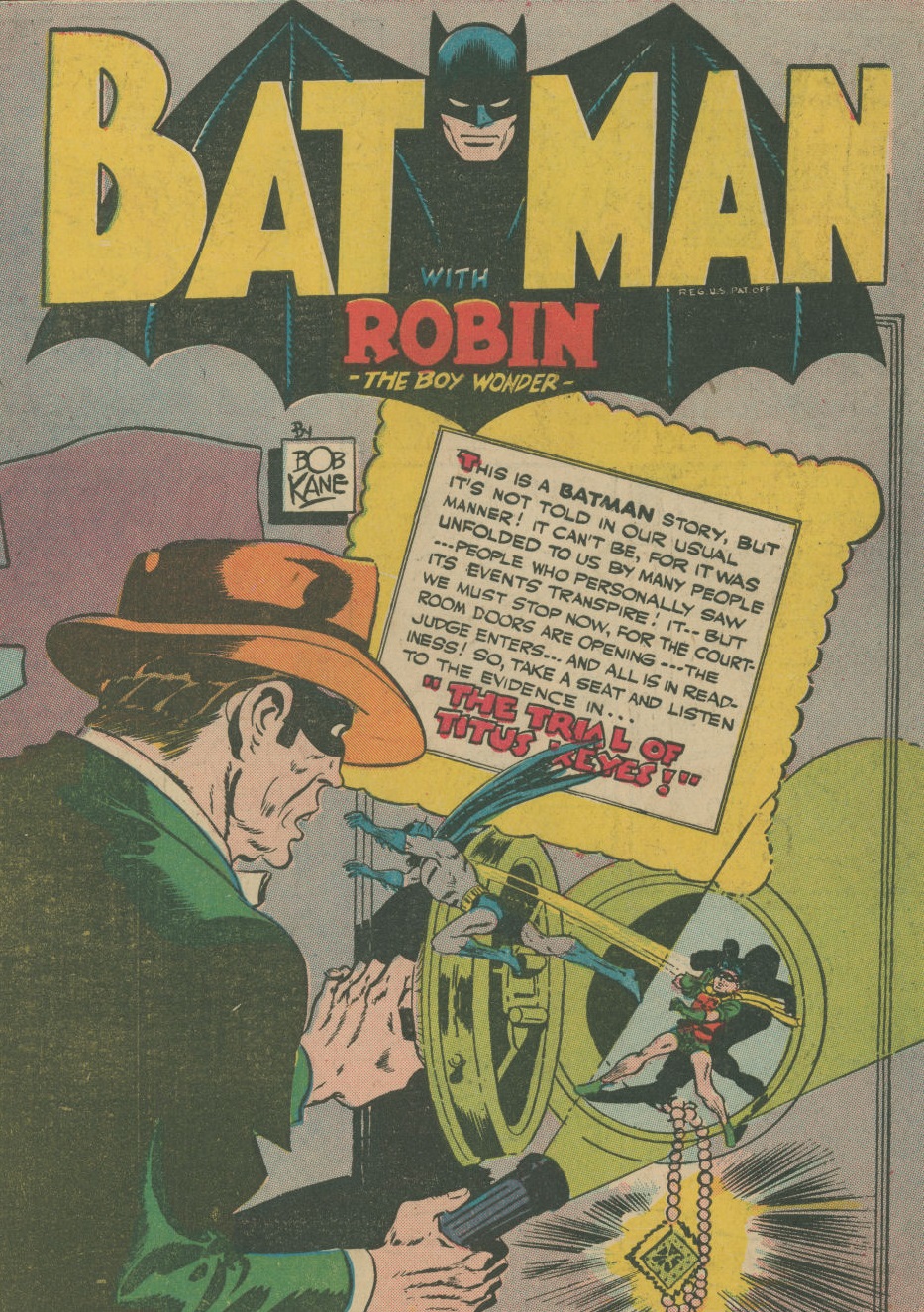
An early experiment in storytelling, probably influenced by Citizen Kane and/or Will Eisner’s The Spirit. I wrote about my love for this story here, including the following lines: ‘Bill Finger was in top form here, crafting a neat courtroom procedural around an innocent-looking man being trialed as an arch-criminal. The comic features many staples of the genre, such as agitated examinations and cross-examinations, a last minute surprise witness, and a plot twist every couple of pages. Finger cleverly figured out a strategy to weave in the action scenes and madcap excitement readers expected from a Batman comic: basically, although the main narrative thread takes place in court, the witnesses’ testimonies become flashbacks revealing parts of the case, namely the parts where Batman and Robin kick butt and take names.’ (12 pages.)
2. ‘Next Stop – Danger!’ (Batman #43, cover-dated October-November 1947), by Bill Finger (script), Jim Mooney (pencils), Ray Burnley (inks), Ira Schnapp (letters)
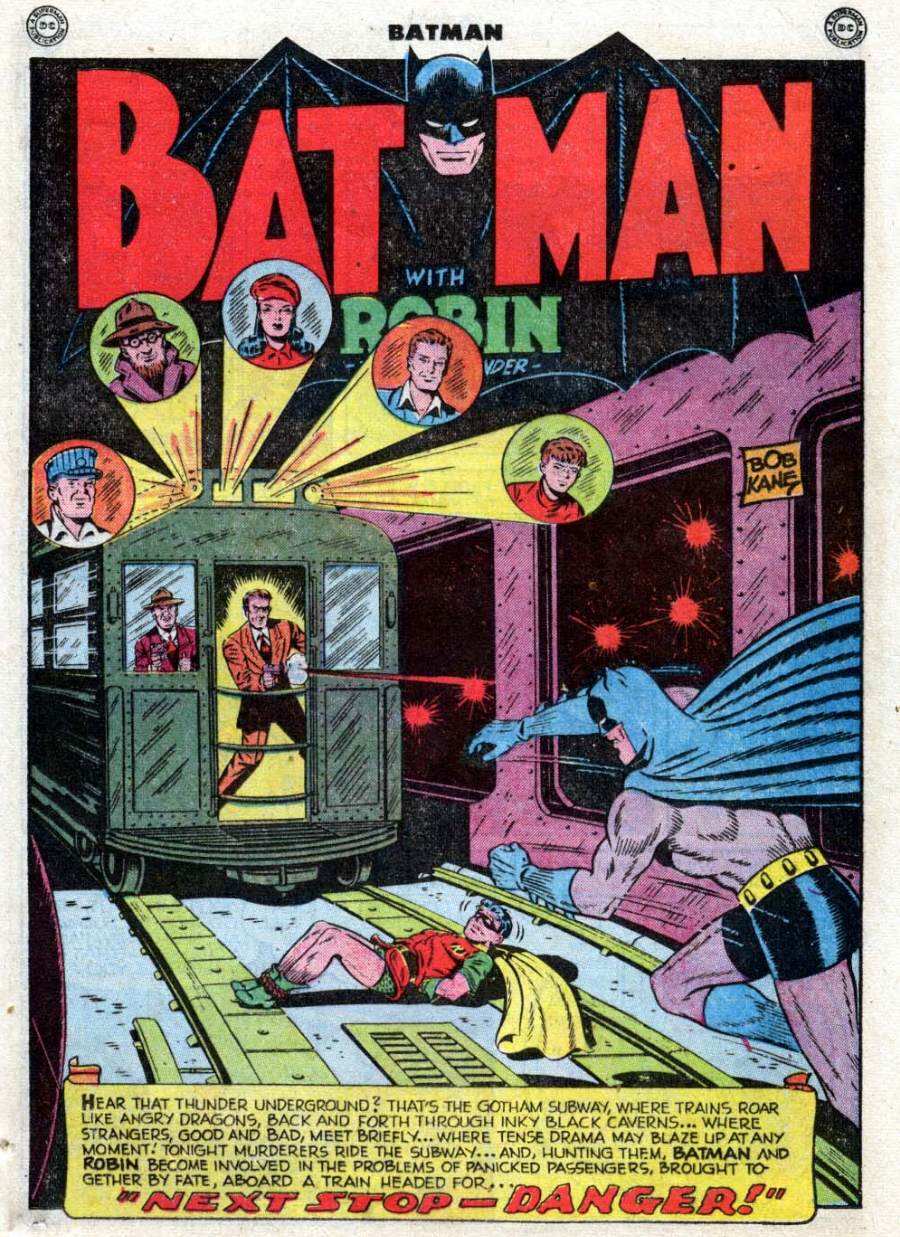
I just can’t get enough of Golden Age stories about how average citizens can be, in their own way, almost as heroic as the Dynamic Duo. In ‘Next Stop – Danger!,’ we follow the paths of a bored subway driver, a blind beggar, an uninspired playwright, a desperate woman, a guilt-ridden newspaper boy, and a couple of wanted racketeers, all of whom end up playing a role in an action-packed Batman adventure (although perhaps it makes more sense to say that Batman is the one playing a supporting role in their own personal sagas). Writer Don Cameron had already toyed with a similar structure five years earlier, in ‘Destination Unknown’ (also taking place in a train ride), but Bill Finger really elevates the idea in this version by imbuing the cast with quite a heartfelt degree of humanity and hints of postwar malaise. I talked a little bit more about it here. (13 pages)
3. ‘The Parasols of Plunder’ (Batman #70, cover-dated April-May 1952), by Bill Woolfolk (script), Bob Kane, Lew Schwartz (pencils), Charles Paris (inks)
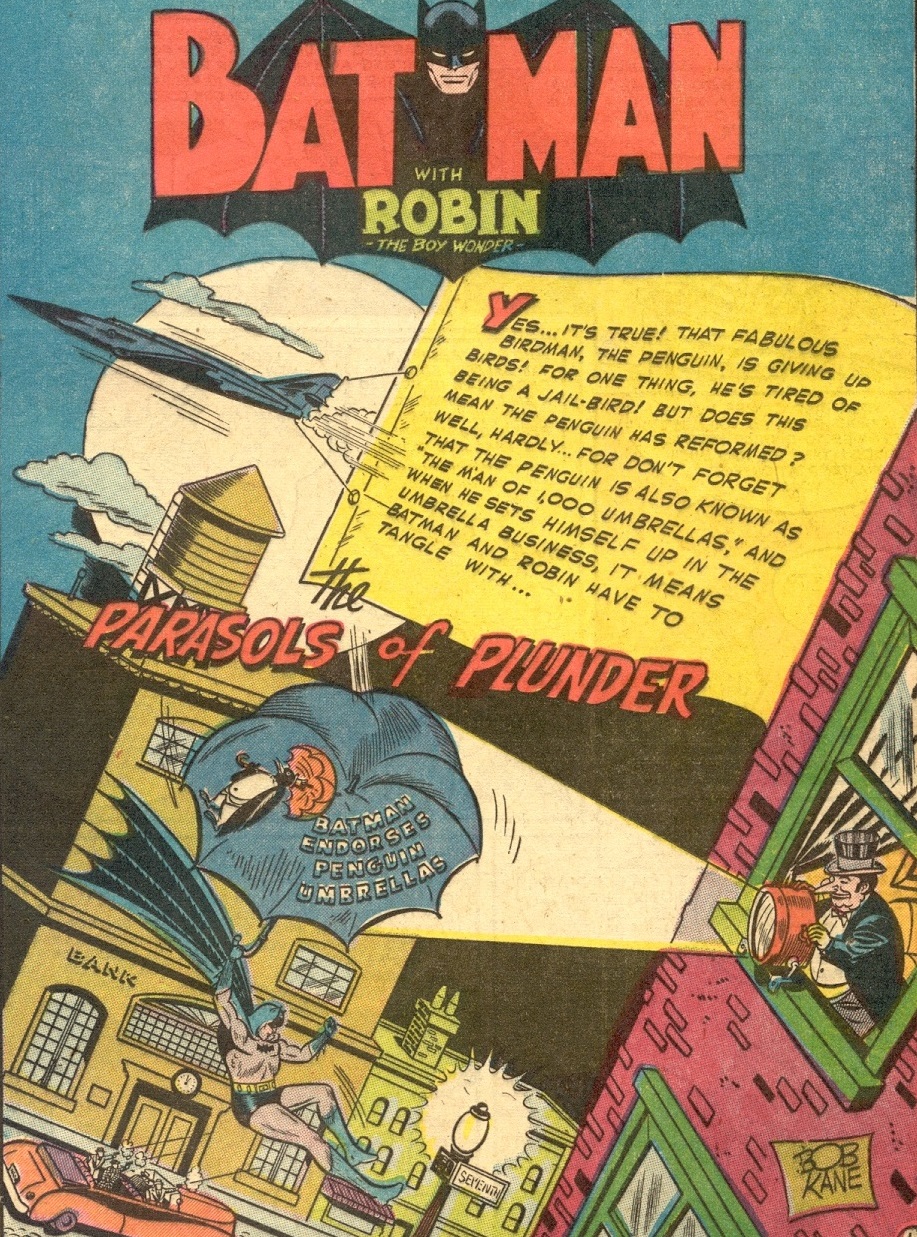
Because Batman comics are also about eccentric villains, wacky plans, and surreal set pieces… There is something charmingly naive about this tale in which the Penguin (‘that grotesque bird of ill-omen’) starts an umbrella business and spends much of the story trying to get the Caped Crusader to endorse his products. The Penguin may be one of Batman’s least interesting rogues in terms of personality, but his looks, his obsession with birds, and his use of umbrellas as weapons often provide fun visuals. ‘The Parasols of Plunder’ is a great example, as it’s full of memorably outlandish confrontations, all of them delightfully brought to life on the page (according to the Grand Comics database, Bob Kane drew the Dynamic Duo and Lew Sayre Schwartz drew the rest, as part of their arrangement at the time). One of the high points is a page that begins with what could’ve been a poster for Jacques Demy’s beautiful musical The Umbrellas of Cherbourg and finishes with a dozen businessmen hilariously hurled through the air by a magnetic statue of Alexander Hamilton. (12 pages)
4. ‘The Nine Worlds of Batman!’ (Detective Comics #208, cover-dated June 1954), by Ed Herron (script), Dick Sprang (pencils), Charles Paris (inks)
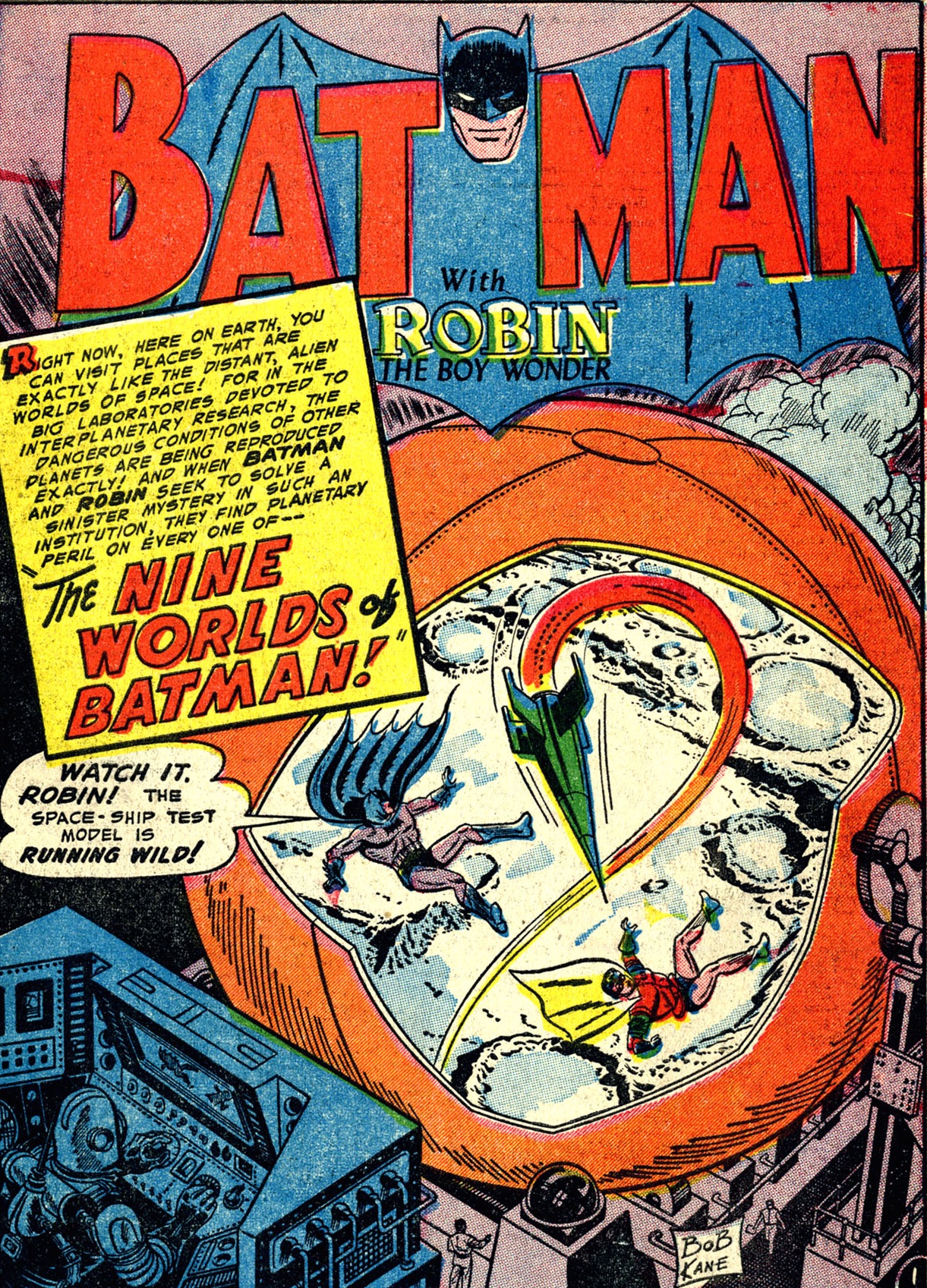
I had to include at least one story drawn by the great Dick Sprang, probably the most popular and influential of Bob Kane’s ghost artists – and the one who visually defined Batman’s transition into the bonkers world of psychedelic science fiction, in the 1950s. In ‘The Nine Worlds of Batman!,’ Sprang gets to go wild with the designs for high-tech machinery and space suits as the World’s Greatest Detective investigates a whodunit at the Space Research College, where each testing chamber turns into a deathtrap. We thus get one of my favorite aspects of Batman comics, which is how they tend to put an offbeat spin on their zeitgeist’s fears and obsessions – in this case, on the Atomic Age’s misuses of science and dreams of space exploration (you can say it was DC’s lighthearted response to the kind of thoughtful, somber sci-fi EC Comics was cranking out at the time, now collected in books like Spawn of Mars and other stories). As a bonus, the action is deliciously hectic (in the first page alone, criminals blow up a bank with a missile, the Dynamic Duo solve a case before speeding to a new crime scene, and Batman figures out an important clue while Commissioner Gordon screams hysterically) and the mystery plot is pretty cool as well, with Batman and Robin trying – and not always succeeding – to stay one step ahead of the criminals. Pure pulpy goodness. (12 pages)
5. ‘The Strange Death of Batman!’ (Detective Comics #347, cover-dated January 1966), by Gardner Fox (script), Carmine Infantino (pencils), Joe Giella (inks), Gaspar Saladino (letters)
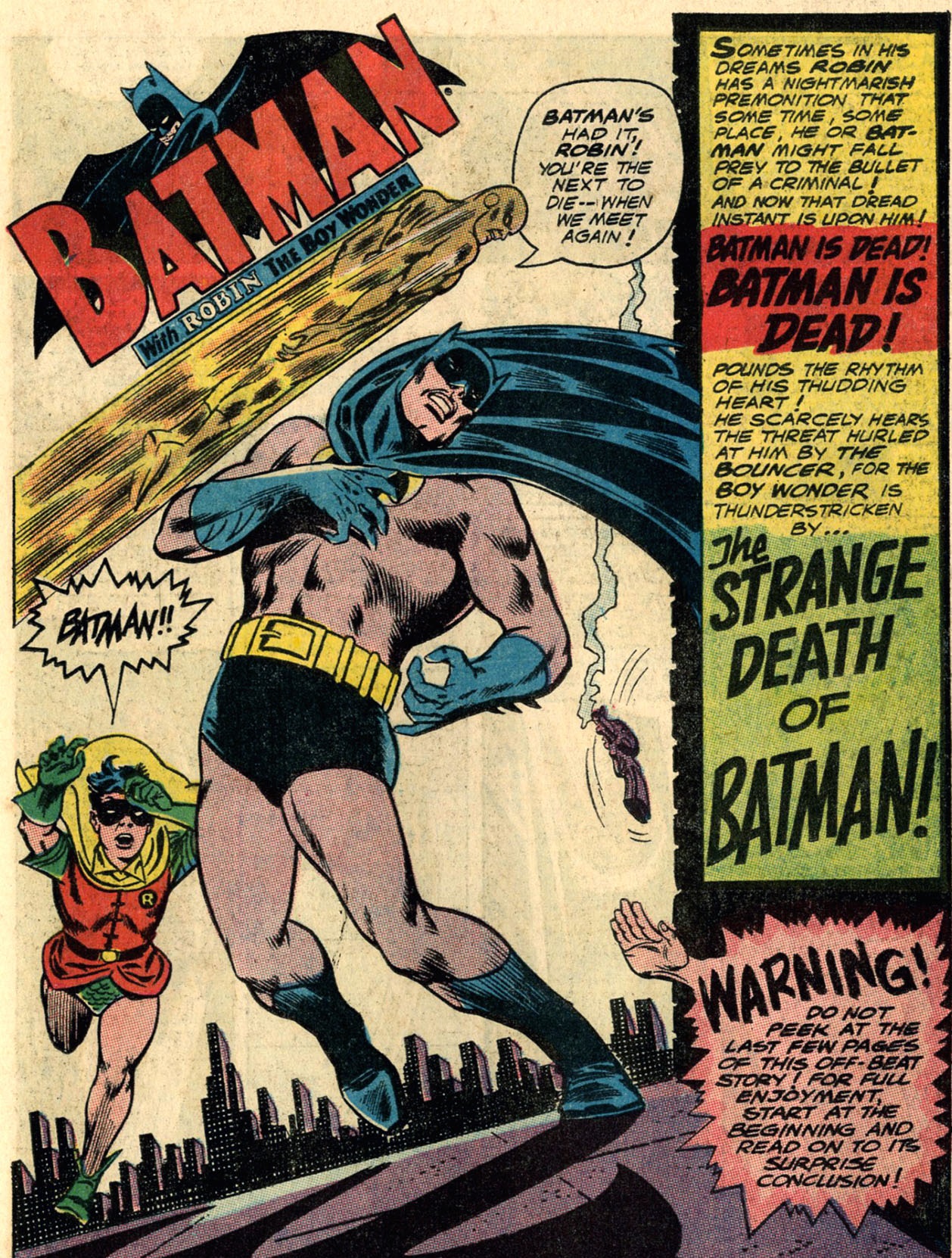
After a courtroom drama and a sci-fi thriller, we get an entry that taps into some of the most appealing tropes of the superhero genre, from its playful reflexivity to the endless potential of multidimensional continuities. That said, who would’ve thought that an issue about an ill-defined villain who looks like a giant rubber ball could be so unforgettable? Obviously, part of the reason is Carmine Infantino’s slick drawing style, which turned the Bouncer’s frenetic, ricochet-prone antics into a thing of grace and beauty. But let’s face it: as fun as it is to see the Bouncer’s confrontations with the Dynamic Duo (who fight him by using their knowledge of elasticity and induction heating, because Gardner Fox never missed a chance to cram some nerdy factoids into his comics), the real high point is the final act of the story, which takes a bizarre metafictional turn… and the twists keep on coming until the end. The result is a lovely ode to Silver Age imagination. (14 pages)
6. ‘The Angel, the Rock and the Cowl!’ (The Brave and the Bold #84, cover-dated June-July 1969), by Bob Haney (script), Neal Adams (art), Ben Oda (letters)
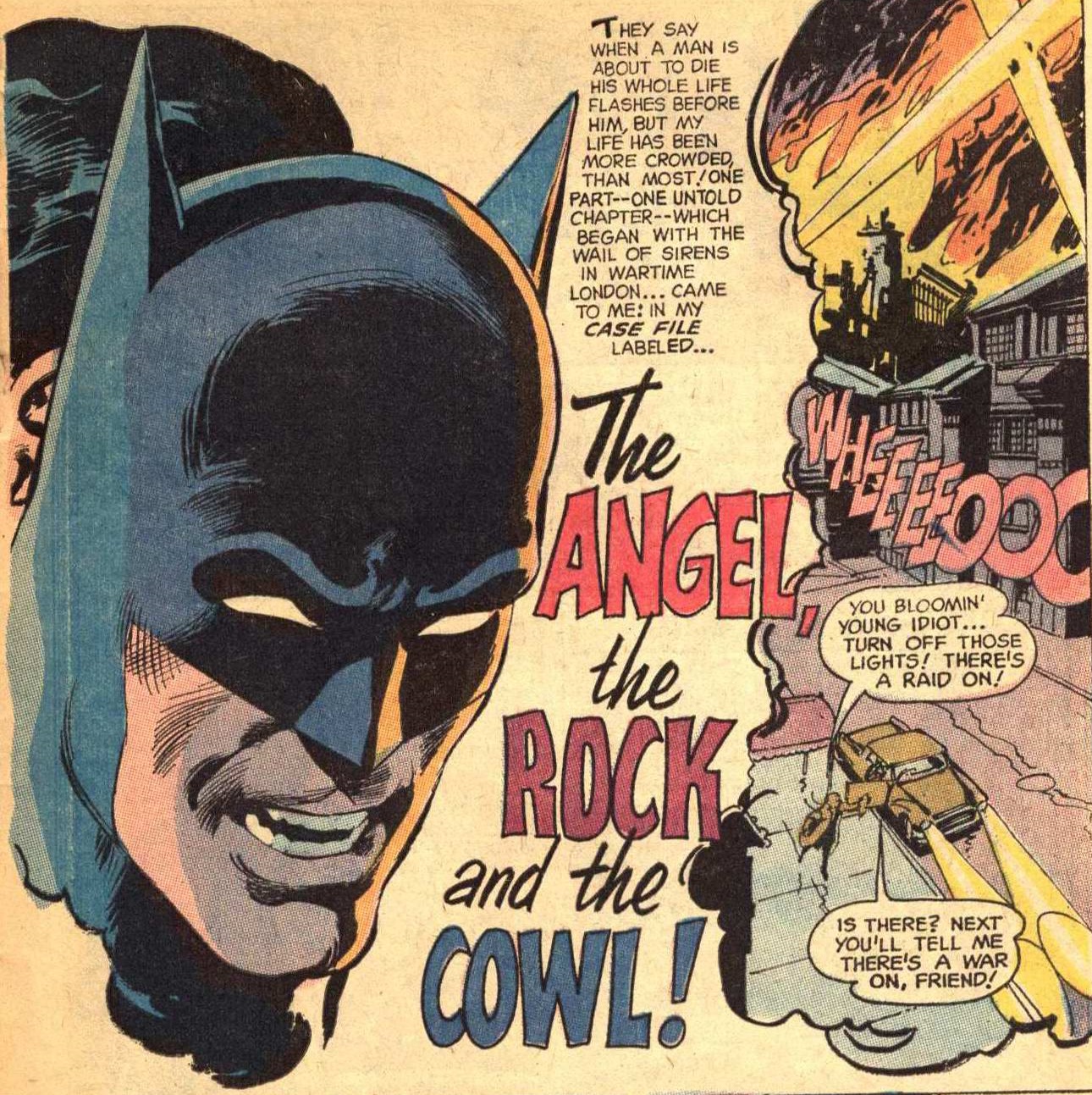
Chronology be damned: in this kickass spy yarn, a still relatively young-looking Batman has a flashback about the time he fought in World War II and bumped into DC’s resident war hero, Sgt Rock. I like my Batman comics with manic energy and a brazenly tasteless attitude, so this one is right up my alley… Bob Haney’s adrenaline-charged script has a James Bond-ish Bruce Wayne – in and out of costume – jump from a motorcycle into a moving airplane, throw a grenade against a German aircraft before parachuting into occupied France, and beat up Nazis every couple of pages. Part of the reason this works so well is Neal Adams’ art, which at the time was muscular yet elegant: thinking of it cinematically, it had the ‘sophisticated adventure’ feel of Michael Powell’s and Emeric Pressburger’s earlier collaborations (like Contraband) and the lush, gothic atmosphere of Hammer classics (like The Curse of Frankenstein). Irresistible. (23 pages)
7. ‘Legend of the Key Hook Lighthouse!’ (Detective Comics #414, cover-dated August 1971), by Denny O’Neil (script), Irv Novick (pencils), Dick Giordano (inks), Gaspar Saladino (letters)
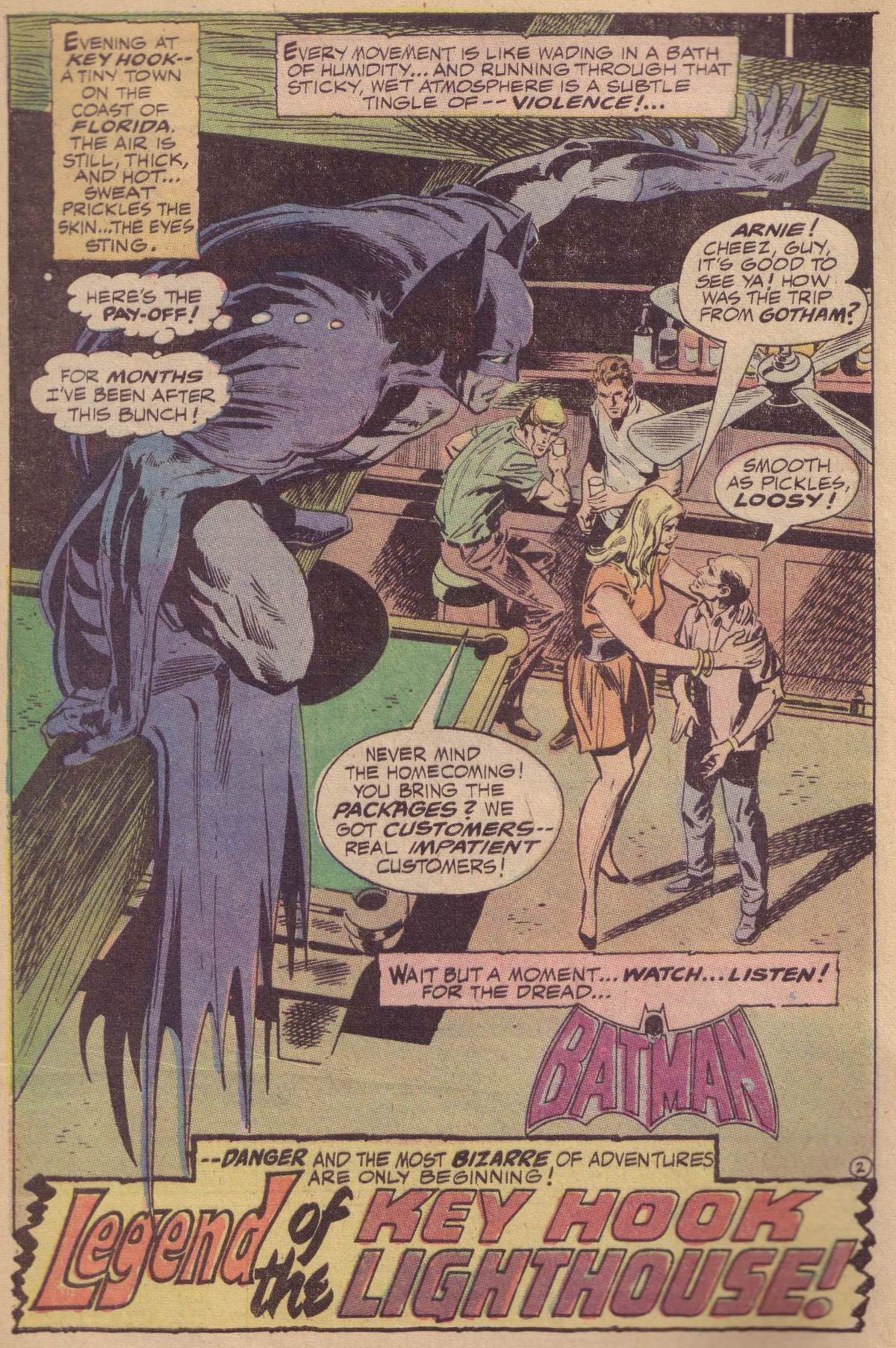
Denny O’Neil’s run in Batman/Detective Comics from the early 1970s holds a special place in my heart – together with Batman Adventures and the Alan Grant/Norm Breyfogle run, these formed my platonic ideal of Batman comics. And it’s not just the classic tales O’Neil wrote for Neal Adams, it’s also the lesser-known stories pencilled by Irv Novick, a veteran of the medium who played almost as big a role as Adams in terms of updating the Dark Knight into an athletic – yet fallible – adventurer who moved between the worlds of gothic horror and film noir. (Dick Giordano, who inked both Adams and Novick, clearly deserves much of the credit as well!). ‘Legend of the Key Hook Lighthouse!’ combines much of what made these comics so great, from the empathic characterization (including a particularly engaging female character) to O’Neil’s purple prose (‘This is the one who exists to right wrongs! – A mind bright as tungsten flamed cased in a superb body’), from the haunting images (Batman emerging from the darkness, the general’s hand in the water) to the poetic ending (in this case, it’s literally a poem). (15 pages)
8. ‘The stage is set… for murder!’ (Detective Comics #425, cover-dated July 1972), by Denny O’Neil (script), Irv Novick (pencils), Dick Giordano (inks), Milt Snappin (letters)
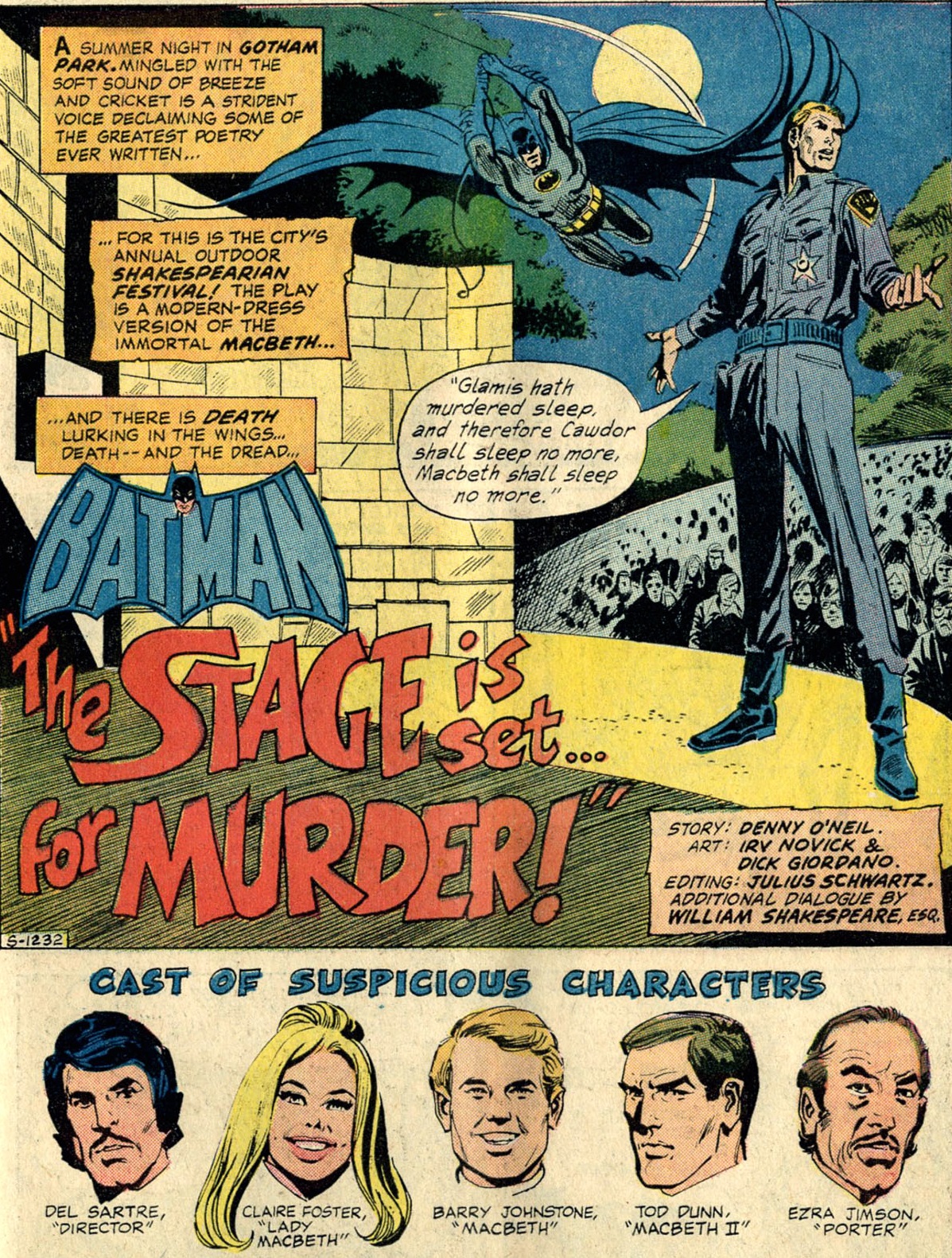
Another O’Neil & Novick collaboration. This is one of their fair play mysteries, somehow managing to establish a bunch of credible suspects and red herrings before Batman figures out the killer. Even though these stories could’ve had more pathos if they had more time to breathe and to flesh out the cast, they are usually neat and clever – and I do get a kick out of seeing Batman own up to his reputation as World’s Greatest Detective. ‘The Stage is set for Murder!’ is probably not the tightest foray into this formula, but I find it particularly entertaining because it’s set around a production of Macbeth, so O’Neil can use the theater milieu to get away with some over-the-top characterization… Both the villain’s motivation and the disguise used early on are kind of ridiculous, yet the exaggerated sense of melodrama and theatricality seem to fit in this context. (15 pages)
9. ‘Killer’s Roulette!’ (Detective Comics #426, cover-dated August 1972), by Frank Robbins (script, art), Ben Oda (letters)
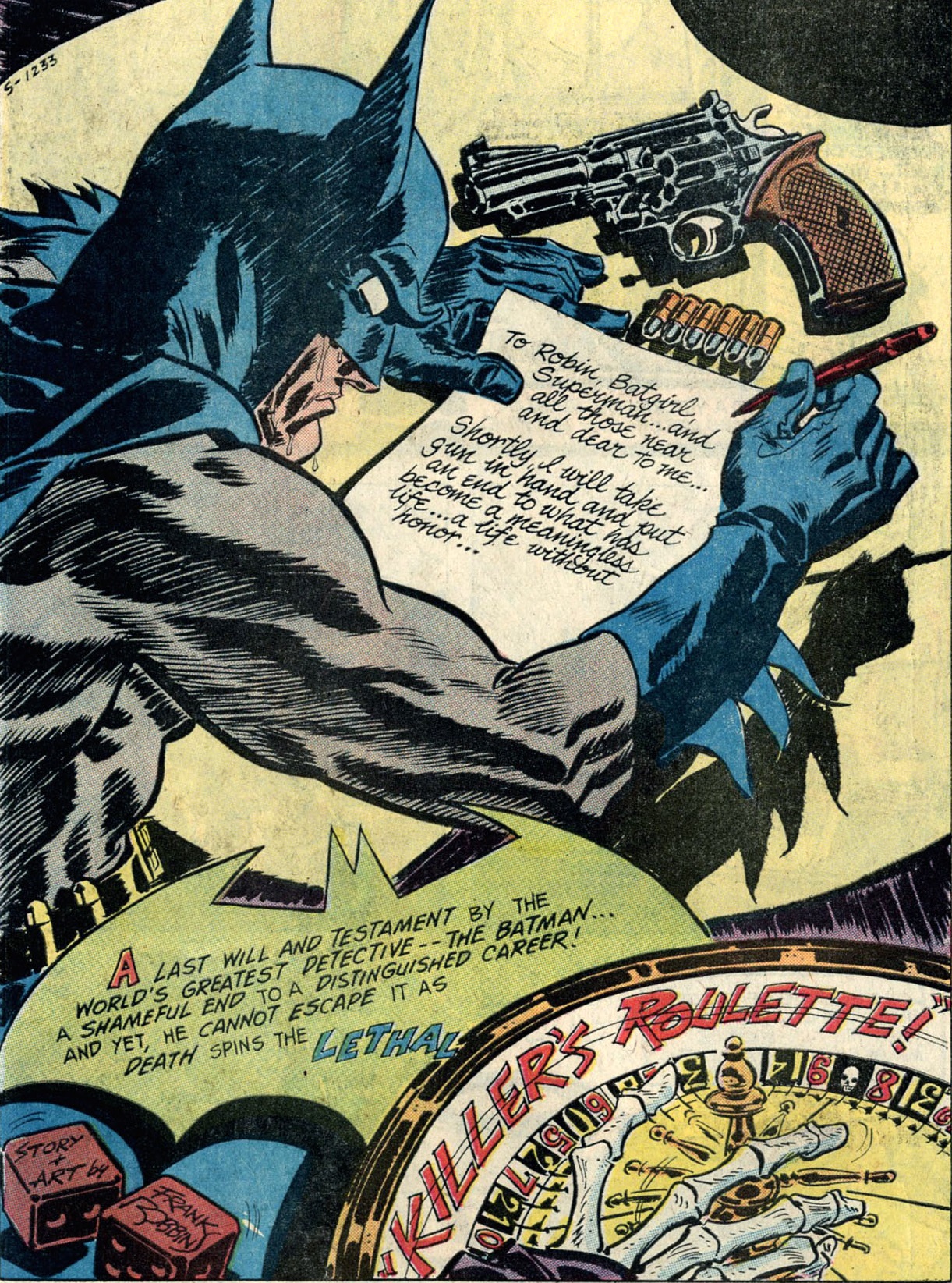
Besides writing dozens of stories about the Dark Knight and his supporting cast, Frank Robbins also drew a handful of them. His style was way more velvety and cartoony than that of other artists in the Batman titles at the time, but it did convey a noirish mood that was perfectly suited to the character. For my money, Robbins’ art was enough to elevate even tales that otherwise felt rushed and somewhat contrived. My favorite of these is ‘Killer’s Roulette!’ Despite the somewhat campy title page, it’s a grim little yarn about gambling with hardboiled dialogue and a truly macabre premise, culminating in an intense – and powerfully illustrated – climax that really pushes Batman’s code against using firearms (not to mention the kind of imagery you could get away with under the Comics Code Authority). (15 pages)
10. ‘The Impossible Escape’ (The Brave and the Bold #112, cover-dated April-May 1974), by Bob Haney (script), Jim Aparo (art, letters)
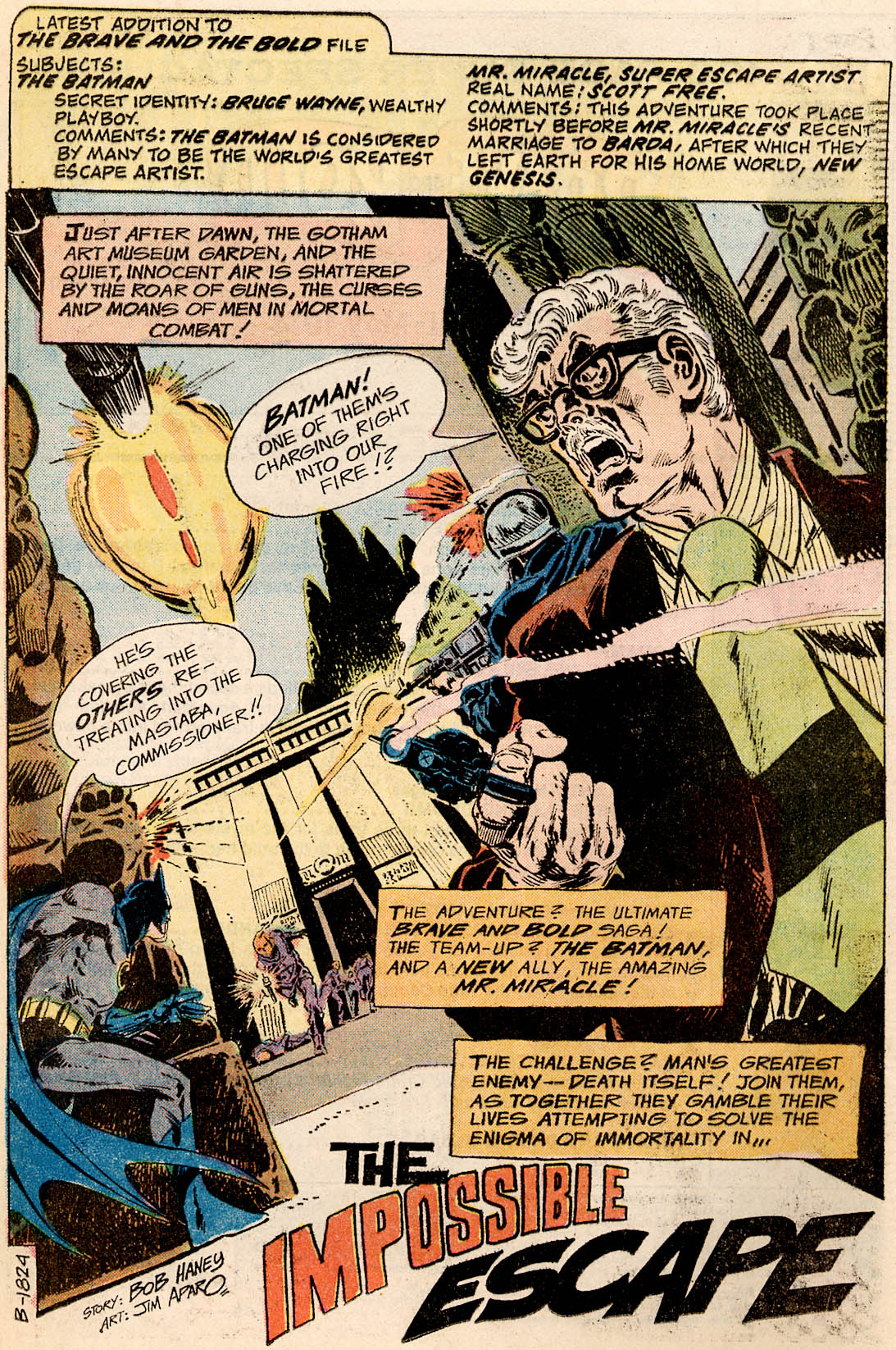
I dig this comic so much that I’ve written about it before. This is what I had to say: ‘From the slam-bang opening in which Batman faces suicidal raiders at the Gotham Art Museum to the climatic chase in an ancient, maze-like Egyptian tomb, this comic never lets go. ‘The Impossible Escape’ keeps adding one off-kilter twist after another at a hell-for-leather, feverishly brisk pace, as is typical of Bob Haney’s and Jim Aparo’s exhilarating run on The Brave and the Bold. Along the way, the Caped Crusader finds himself in a trap-filled pulp adventure that may lead him to the elusive secret of immortality. He also teams up with Mr. Miracle, the alien escape artist created by the legendary Jack Kirby. What a blast!’ (By the way, Batman’s subsequent team-ups with Mr. Miracle – the Cold War-tinged ‘Death by the Ounce’ and the sci-fi-ish ‘Mile High Tombstone!’ – are packed with almost as many shameless thrills and crazy ideas.) (20 pages)
